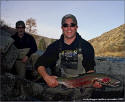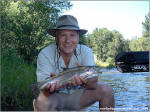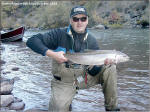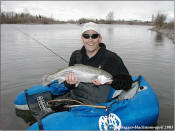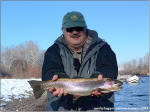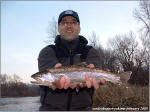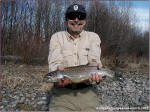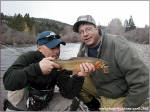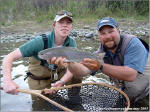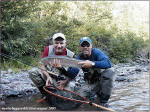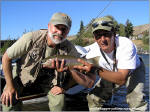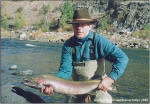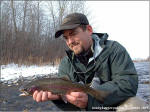|
December 17th-2005 |
|
|
With Christmas less
than a week away, frigid temperatures that we usually experience
during the month of January, continue to
dominate the Kittitas Valley. Single digit, crisp
clear mornings have a firm grip on the Yakima River Basin.
Huge mounds of ice have formed in and along the river,
freezing passage in the slow moving pools of the Yakima.
|
|
|
The lower Yakima River
Canyon in many areas is completely sheeted with ice.
Upper portions of the river are open and fishable, as ice
has formed in and around the shoreline. Areas of
the Yakima on a steeper gradient with plenty of current,
remain ice free. Believe it or not, the
die hard winter trout fishermen are on the river fishing
during the sunny December afternoons. |
|
 |
|
Low, clear, cold
water conditions have the resident Whitefish busy moving
gravel along the river bottom during the day. Spawning
activity occurs for this native species of the Yakima this
time of year throughout the entire river. The rainbows
take advantage of this daily event and forage. An easy
meal for them this time of year, when insect hatches are
solely contributed to tiny midges. |
|
|
Just because its
the middle of winter don't assume the insect activity is non
existent on this Central Washington trout stream. A
massive stonefly migration is underway as the Skwalla Stones
begin their ascent to the shallow shorelines of the Yakima.
Hearty, winter forage for the Yakima River Rainbows.
|
|
|
|
|
|
|
|
|
|
With the
month of December underway, another winter snow storm has
blanketed the Yakima River Valley, dressing the surrounding
hillsides and river banks in a seasonal holiday wonderland. The
blizzards are a blessing for everyone, after enduring the
consequences of last years mild, storm-less winter. Piles of
the frosty white matter is building in volumes, high atop the
Cascade Mountain Range. Come spring, as the warming
temperatures develop, these accumulations of precipitation will
begin melting and once again fill the headwater reservoirs of
the Yakima. |
|
WBFC-Guided
Tour Information |
|
Fly fish
Central Washington this season with the, The
Worley Bugger Fly Co. 888-950-FISH. |
|
|
|
|
|
|
 Click To
Enlarge Thumbnail Click To
Enlarge Thumbnail |
|
|
|
|
|
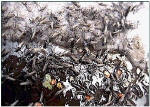 |
 |
|
|
|
|
Midge Cluster |
Midge Adult |
|
|
|
|
|
|
|
Family: |
Chironomidae |
|
Order: |
Diptera |
|
Common
Name: |
Midge |
|
Emergence: |
Spring-Fall-Winter |
|
Imitations: |
Name: |
Size |
 |
Nymph |
Tung Zebra Midge |
#22 |
 |
Adult |
Griffiths Gnat |
#22 |
|
 Click To Enlarge Thumbnail
Click To Enlarge Thumbnail |
|
 |
 |
|
Yakima River Winter Stonefly |
|
|
|
Chilly Ellensburg mornings quickly give way to warmer
afternoons as that infamous Central Washington sunshine
beams across the river basin. |
| |
|
Its
warmth provides adequate time to wet a line in the
winter waters of the Yakima. Bright , sunny days are
forecasted for the entire week. |
| |
|
The
river is in great condition flowing low, much like what
you would expect to find this time of year.
|
| |
|
Local
fly fishers are taking advantage of the conditions and
enjoying the fruits of a crowd less river. |
| |
|
With
the appropriate wading gear, a fly fishermen can stay
warm and comfortable throughout the day. |
| |
|
Finding a willing fish to participate in the daily
events isn't especially difficult either. The rainbows
have taken up residency in their winter holding lies of
the Yakima. Spending the time finding them is far less
complicated this time of year. |
|
|
PRO-SHOP SALE |
|
|
|
 GUIDED TOUR
GIFT CERTIFICATES
GUIDED TOUR
GIFT CERTIFICATES |
| |
|
Holiday
Guided Tour Raffle |
|
Worley Bugger Fly Co. would like to say thank you
to the Yakima River Fly Fishing Community this
holiday season. |
 |
|
As away, WBFC is raffling a "FREE" Full Day,
Yakima River guided tour. Starting December 5th,
spend $50.00 or more in the Ellensburg Pro Shop or
by shopping online through the extensive Worley
Bugger Internet Catalog and be automatically
registered in the drawing. The results of the
raffle will be held January 31st-2006. (DETAILS) |
|
|
|
|
|
|
|
"Current
Insect Activity" |
|
|
|
|
|
|
|
|
|
|
|
|
|
WBFC
Pro-Shop Hours Of Operation |
|
8:00
a.m.-5:30 p.m |
|
7 Days A Week |
|
|
|
|
"Yakima River Flows" |
|
 |
Easton Flow |
180 |
cfs. |
 |
Cle Elum Flow |
422 |
cfs. |
 |
Teanaway Flow |
500 |
cfs. |
 |
Eburg Flow |
620 |
cfs. |
 |
Umtanum Flow |
640 |
cfs. |
|
|
|
|
|
You will
encounter a diversity of fish in each run as Whitefish and
other resident species share the water with the Yakima River
Rainbows. For those that may find winter wading in the
Yakima uninviting, the option of a warm, heated fly fishing
drift boat is always an alternative. Take advantage of our
great seasonal rates, catch a few fish and spend the day on
the river. What could better! The spring creek waters of
Rocky Ford are always an option for the bank fishermen as
well. Reports from the die hard, winter fly fishing
enthusiasts late last week, reported good fishing with Baetis and Midges. |
|
|
|
This
holiday season treat yourself or your fishing partner to a
Worley Bugger guided tour gift
certificate. A variety of fly fishing
adventures are available and continue to be an extremely
popular gift each season. Please contact the pro shop if
you have any questions or would like to purchase one for the
deserving fly fishermen on your list this year. |
|
|
|
The
Klickitat River fly fishing season ended this past
Wednesday, the 30th of November. Summer steelheading got
started late this year as the fish slowly migrated into the
river. Low, warmer than usual water conditions, some of the
lowest every recorded on the Klickitat were partially to
blame. However, by late August the fish numbers were
picking up considerably and the Fall fishing on this south
central Washington river was pretty exciting. Were already
looking forward to the June 1st-2006 summer steelhead
opener. Thanks to all our guests that fished with us. It
was great showing you this magnificent piece of water. |
|
|
|
|
|
As the frosty mornings
begin in the Yakima River Valley, thick fog banks cover the
hillsides of this quiet little farming community. The thin
layer of snow that blanketed the surrounding ridges several days
ago, beams lightly along the hill tops. The peaks of the Cascade
Mountain Range, cresting in the western skyline are once again draped in
snow. Like usual, the first portion of
November was cool here in the central basin, a climatic change from
what we experience during the month of October. However,
most days the warmth
of the afternoon sunshine slices through the low lying fog,
crafting an ideal day for the die hard late season trout or summer
steelhead fishermen in Central Washington's rivers and streams. |
|
|
|
With the changes
occurring in our seasons, the Yakima River is no exception.
Transformation from one season to the next is an unscheduled
event that takes place each year, dictated by weather
and water conditions. |
|
|
|
The resident
fish of the Yakima are adjusting and have begun taking
up holding lies in the winter waters of this classic
western trout stream. Here, river waters warm much
quicker during the shorter sun periods of the day.
These waters also produce the winter seasons specific
aquatic insect emergences during the afternoon. Baetis
Mayflies are still a daily occurrence and will continue
through the remainder of the month.
Hatches are quite lighter than what you may have encountered
during October and can be river section
specific. |
|
|
|
The much
smaller midge is now playing its role as one of the trout's winter food sources as well. Those fly
fishermen looking to target specific surface feeders
on these tiny aquatics will find areas of the lower
Yakima River Canyon your best bet for these winter time Chironomid
emergences. |
|
|
|
The small Winter
Stoneflies will also be a food source throughout the winter
months of December and January. The nymphs are now a
critical portion of the food chain, however feeding on
adult stones will occur in particular water types during the
afternoons. |
|
|
|
The summer Steelhead
fishing continues on both the
Klickitat
and
Methow River with both of these beautiful Washington
rivers producing fun filled fishing days. Both rivers
are operating at below normal stream volume, however the
Klickitat Valley did received some much needed rainfall over
the past weekend. Typically a moderate rain shower
will diminish the Klickitat's clarity and produce a glacier
tint to the stream. However, on Monday the river had
just a hint of color, perfect for fishing low water conditions. The Klickitat steelhead
season comes to a close on Wednesday, November 30th.
The Methow River, will remain open indefinitely throughout
the winter months. |
|
|
|
For those fly
fishermen looking for more consistent surface
activity and would prefer not to wade the cool waters of the
Yakima, the central basin waters of Rocky Ford is always a
viable option throughout the winter months. Consistent
hatches of Baetis and Midges will occur at this desert
spring creek on a daily basis. |
|
|
|
|
|
As the first day of
November begins, consecutive early morning rain showers have
fallen over the Yakima River Valley. A much needed shot of
water has entered the lower rivers system, via a host of
tributaries that feed this Central Washington trout stream.
The Fall eye candy that has been brilliantly
displayed along the banks and hillsides of the Yakima during the
month, is slowly falling away. Cooler, night time
temperatures have settled in as the Kittitas Valley under goes
the transformation of yet another season. |
|
|
|
Fly fishermen were
out in full force this past weekend taking advantage of the
beautiful Fall days. Sunny, warm
afternoons prevailed, providing perfect conditions for a
late October fly fishing experience. As daylight
savings time comes to an end and we fall back one hour in time, you
can expect the hatches also to begin later in the afternoon. The
emergence of Baetis and Mahogany Dun Mayflies is still active throughout the majority of the lower Yakima
River. |
|
|
|
Throughout the
first portions of November, expect to see these mayfly
emergences begin in the latter portions of the
afternoon. As the month progresses and colder
temperatures become a regularity, these mayflies
appearances will thin and the Yakima rainbows will begin moving
into their winter holding waters.
Their concentrations on other vital winter food sources
will become important throughout the remainder of
November, continuing throughout the holiday month of
December. October Caddis continue playing an
important role in the daily aquatic insect activity on the
Yakima during the latter portions of the day. |
|
|
|
The lower
canyon sections of the river is experiencing some hatches, however
the Farmlands and Upper Yakima have a much higher density of these
giant Halloween Caddis. The pupa stages of the insect being of far
greater consequence to resident rainbows than the adults. You
can expect to see this giant caddisflies daily appearances diminish
as the month of November progresses. |
|
|
|
The east side
Steelhead fishing continues, as the last month of the
Klickitat River
season begins. Closure on the
river is November 30th. Over the past week, Fall
Chinooks have moved into the upper sections of the river
taking over the shallow portions of the river bed for
spawning purposes. This activity will begin to
diminishing as the month progresses and steelhead will once
again have the river to themselves. The
Methow River is experiencing the same natural phenomenon
and will remain open for summer steelhead fishing throughout the
remaining months of winter. For guided tour
information and availably throughout the month of November,
please call the pro shop. |
|
|
|
The still water
fisheries of the central portion of our state also remain
busy with fly fishermen. Lake Lenore is offering
Cutthroat fishing and Lake Lenice and Nunnally report good
fishing for browns and rainbows in the shallower waters.
Blackstone Lake, located in the Kittitas Valley is no
exception. Guided tours are available to this private
trophy fishery throughout the month of November. |
|
|
|
|
|
As we approach the
middle portion of the month, hatches of Mayflies and Caddisflies
are a daily event on Central Washington's, Yakima River.
Vibrant Fall colors, adorn the banks of this classic western
river as the Cottonwoods and other stream side foliage present a
spectacular, picturesque exhibition of Mother Nature at her
finest. Its hard to imagine a finer month of the year than
October to be fly fishing in the Pacific Northwest. |
|
|
|
Anadromous
migrating
rainbows are returning to the rivers in great numbers. The
Klickitat,
Methow and Grande Ronde Rivers are all reporting good steelhead
stats at this time. Spawning Fall Chinook and Coho
Salmon are busy building redds in streams across the state,
while bull elk preoccupied with the rutt are bugling in the
river bottoms of the Yakima. Fall Baetis
continue to steal the show as their emergence
begins during the early portions of the afternoon.
Rainbows, busy during
this mayfly event are slurping these tiny food forms
from the surface
film. |
|
|
|
For some,
frustrating circumstances can arise during this time.
Presenting a tiny imitation to match the natural insect
can at times produce discouraging results. One
obstacle that I see many times on the river is the
"over-caster". Casting forty or fifty feet of fly line in
these water conditions puts you out of the game, especially
from a boat. |
|
|
|
The low, clear
water flows provide the Yakima rainbows with a distinct
advantage. At times, even when you may think you
are achieving the drag free drift, bits of micro drag can be
amplified on the fly line, leader and fly. Creating
shorter casts while working smaller amounts of line and
water in combination with a productive pattern will
provide you with much more consistent fishing action. |
|
|
|
Mahogany Dun
Mayflies as well as the Light Cahill Mayfly continue their
afternoon appearances. This is a much shorter lived
hatch than the Blue Wing Olives, lasting approximately
thirty minutes to an hour in most cases. The fish do
key in on their presence, so make sure you are equipped with
appropriate patterns to match the natural. |
|
|
|
The Fall Caddis in
the early evening hours are also a target for Yakima
Rainbows. You may only see a handful of these hatching
Giant Orange Sedges, however that is enough for the fish to
key on their presence. This is a good time to fish the
"pupa" imitation as larger size rainbows seek out this
substantial sub surface meal. |
|
|
|
|
|
After a week of warm
sunny weather, proceeded by a wet, drizzly weekend, a
transformation has taken place throughout the Yakima River
system. Frosty night time lows have proliferated the
aquatic insect activity, especially the mayfly emergences.
Baetis, Mahogany Duns and Light Cahills are all an important
factor throughout your day of Yakima River fly fishing.
Today, warm temperatures and overcast skies have created the
ideal Fall fishing scenario. |
|
|
|
The warmer weather
we experienced last week continued to produce adult stonefly
activity. However, now with the cooler October
temperatures settling in, this week we have seen a
noticeable difference in this summer stoneflies afternoon
appearance. Most likely, this significant Yakima River
stonefly has completed it cycle for the year. |
|
|
|
The Giant
Orange Sedge or October Caddis has become a familiar site in
specific areas of the river in the late afternoons.
The farmlands and upper portions of the Yakima have a much
more concentrated hatch than what you will encounter
throughout the lower canyon sections. These gigantic,
bright orange Caddis flies attract undue attentions as they
emerge breaking the waters surface. |
|
|
|
The egg laying
females, much like their smaller counterparts thrash and
flay on the top of the water during this process. Its during
this time they become an important factor to the Fall dry
fly fishermen. Favorite
imitation to match the natural are, the Norm Woods, the
Stimulator or Slickwater Caddis. These patterns
can be fished on a dead drift or with a skating,
twitching motion.
|
|
|
|
During the early
portion of the afternoon, clouds of Baetis Mayflies begin
hatching. Mixed within the emergence of this tiny,
olive bodied insect are the larger, Mahogany Dun Mayflies.
At this time, you may find it productive to present a tandem
selection of dry flies to hatch both of the naturals.
The Yakima rainbows will be actively feeding on both aquatic
insects. Presenting distinct imitations will provide
you with two things. It gives fish the diversity
that are looking for and it also aids the presenter with a
larger silhouette to identify the much smaller trailing
pattern. Often times, the glare given off by the
afternoon water surface or the fact that the fish feed
inattentively in the foam lines can present some low
visibility problems. The larger point flies helps
correct the problem and increases your fishing
opportunities. In some areas of the river, Light
Cahills, a pale bodied mayfly much like the P.M.D.
will also be apparent during the afternoon. |
|
|
|
The pro shop has
fielded many calls this week about the flow of the river.
It is operating at a very low volume, however it is
still quite drift able. Even with the low volume of
water, your odds of having a successful fishing day go up
considerably while fishing from a boat. You will find
trout holding in specific water and definitive Fall water
types. Being able to move quickly, gives you more
flexibility and the upper edge on your wily opponent. |
|
|
|
Last weeks rain
storm didn't do much for our steelhead fishing on Southeast
Washington's,
Klickitat River. A heavy down pour of rain, touched down
in the Klickitat Valley and the tributaries known locally as
the "Big Muddy and Little Muddy" flowing from Mount Adams
began spewing mud into the river. Visibility was non
existent and our tours were postponed to a later date.
Drier conditions this week have dropped river flows once
again and enough clarity has returned for fishing.
With the increase in water, a new push of steelhead and
salmon have coursed through the Klickitat system. |
|
|
|
Washington State's
North Central Steelhead river, the
Methow will open this Saturday, October 8th.
Steelhead and Salmon continue to breach the Bonneville Dam
by the thousands and are now moving over the other Columbia
River barriers in big numbers. Professional guided
tours are available throughout the entire Fall and Winter
season. Contact the pro shop directly for dates and
availability for both the Methow and Klickitat Rivers. |
|
|
|
|
|
As the first official
calendar day of Fall commences, beautiful fly fishing days reign
over the Yakima River Valley. Evidence of a changing
season is already visible. The rivers towering Cottonwood Trees
that shield us from the spring winds have begun to shed their
yearly coat. Stream foliage that grew lush during the hot
days of summer is beginning its transformation into brilliant
Fall colors. Cooling night time temperatures have settled into the Kittitas Valley.
|
|
|
|
Its hard to
imagine a better time to be fly fishing than the month
of October. Stream flows are low, several varieties of
aquatic insects have begun their seasonal emergence cycle
and the rivers are adorn in vibrant color. A nip
in the morning air gives way to warm, comfortable
afternoons. |
|
|
|
This past
week, we observed the several stages of aquatic insects. Mahogany Duns, Baetis and the Yakima's
Fall pale toned mayfly, the Light Cahill were present. The Shortwing
Stonefly continued to play its part in the days fishing
as well. This week we expect to see the summer stonefly
hatch begin to thin. |
|
|
|
Good numbers
of October Caddis appeared during the latter portions of
the day. This large Fall
food form will become a highly important part of the food chain
throughout the remaining months of Fall. Don't overlook
its Importance, especially during the early morning and
late afternoons, when this insect is most active.
Pupa and adult patterns will be an essential part of
your fly box arsenal. |
|
|
|
Expect to see more
condensed hatches of this Caddisfly throughout the Farmlands
and upper portions of the Yakima's system. The Lower
Canyon does experience a hatch of these Giant Halloween
Sedges, however not near the numbers that will occur
throughout Upper River. Hydropsyche Caddis
(spotted sedge)
as well are apparent in the late mornings. Appropriate
patterns of color and size in pupa, emergers and adults
fished throughout the mid day can be productive throughout
most of the upper portions of the Yakima. |
|
|
|
This time of year, returning
stocks of Yakima Chinook Salmon also play a major role in the daily
feeding habits of our resident rainbows. These large anadromous
fish begin the end of their life cycle as their spawning rituals
commence throughout the Upper Yakima
River system. Don't neglect their significance in the
river either! Over the past several years, the higher
presence of Chinook's has helped
nurture the river, producing another highly nourishable Fall food source
for the resident fish population.
Their existence in the Yakima has also helped proliferated the presence of more aquatic
insects. More aquatics = larger trout! |
|
|
|
The
Klickitat River
is now
experiencing a big push of Steelhead and Salmon moving
through its system as well. This Southwestern
Washington River was opened two months early this year in
anticipation of a high number of hatchery strains of fish
returning. Low, warm water slowed the numbers, however
now as the Fall Salmon make their journey upriver,
Steelhead of both hatchery and wild origins are
following close at hand. In recent days, we
experienced multiple hooks ups with both hatchery and wild
fish. Hooking, fighting and landing these strong,
beautiful fish is a formidable task for any fly fishermen.
For guided tour information, please contact the pro shop in
Ellensburg for dates and availability throughout the months
of October and November. |
|
|
|
With cooler
weather now occurring, the stillwaters of the central area
of our state are once again on the minds of many fly
fishermen. Reports from the desert fisheries has been
good. Callibaetis Mayflies are present as well as some
lingering Damsel Fly activity.
Blackstone Lake
, located in the beautiful
Kittitas Valley is no exception. For guided tour
information to this premier stillwater, please contact the
pro shop in Ellensburg for dates and availability. |
|
|
|
|
|
Perfect over cast
days blanketed the Kittitas Valley over the past weekend,
fashioning an ideal fly fishing scenario unlike we have seen on
the Yakima in several weeks. The extended weather forecast
is predicting more of the same patterns for the upcoming week. With river flows now
operating at Fall volumes, wading opportunities abound
throughout the entire river system. |
|
|
|
Cool night time
temperatures and mild September days now dominate the
entire Yakima River Valley. With the reduction
in river flows and a decrease in summer water temperatures,
the aquatic life on the Yakima is once again coming to life.
At times throughout the day, several hatches of Baetis
Mayflies will spark an interest as fish find feeding
opportunities. |
|
|
|
The Yakima's
larger sized Fall mayfly, the Mahogany Dun is also
starting to appear throughout the water column. A
seine sample will confirm the contents of aquatic life
filtering through the river system for you. |
|
|
|
Low Fall flows
have condensed the river, creating a funnel effect for
day time, free drifting aquatic organisms. At specific times
during the early afternoon, various species of mayflies,
caddisflies and stoneflies will begin an aquatic drift.
These are key feeding time cycles. The factors
that trigger these aquatic drifts. Time of day,
weather conditions and water temperature.
|
|
|
|
You can also
expect to encounter the giant, female Shortwing Stoneflies
in the latter portions of the afternoon. Their hard
to miss as they begin their egg laying process. This
stonefly takes on the appearance of a small bird flying
across the river. It crashes on the waters
surface, creating a violent ruckus with its body. Casting
large dry flies during this period has produced plenty of
top water action! Their is also still plenty of
terrestrial activity along the thick, dry grasses of the
river. Don't ignore these areas, especially during the
breezy portions of the day. |
|
|
|
For those looking
to drift the Yakima this weekend, low flows have
definitely made it more challenging. Plot your course
and choose your spot carefully throughout some areas
of the river. |
|
|
|
Blackstone Lake , Central Washington's premier pay to
play still water fishery will open once again under the
exclusive management of W.B.F.C. for Fall
fishing on Friday, September 16th. Some guiding days have already been reserved for the month of October, however their are
days available for the end of September. You can
expect very good dry fly fishing with Damsels and
Terrestrial patterns through the end of the month, possibly
lasting into the first days of October. At this point
its all weather related. The lake is still producing
a great damselfly hatch on a daily basis and the hoppers are
clustered along the banks by the hundreds. Blackstone
rainbows have been feasting on both all summer long.
To book your day, please contact the pro-shop for dates and
availability. |
|
|
|
The
Klickitat River in Southwest Washington, continues to free flow
well below normal flows for this time of year as well
(Today-469 cfs.) Steelhead counts in the Columbia
River compared to last year still remain lower, however
3000+ fish a day continue to breach the Bonneville Dam.
The Fall Chinooks as well are moving over this first man
made barrier on the Columbia at a rate of about 15,000+ fish
per day with a Y.T.D. total of 306,000+ salmon. We
expect to see a good push of late summer steelhead that have
been holding in the lower Klickitat to follow the Chinooks
upward through the system. I would expect to see good
Klickitat steel heading through the remainder of the month
lasting well until the last day of November. We are
still waiting to hear about a possible Methow River opening
for steelhead. According to sources, a decision on
that subject should come early next week. If by chance
we do see the river open, Andy Hanson of Worley Bugger Fly
Co. will be conducting professional guided tours throughout
the Methow season. Andy, a long time resident of
Eastern Washington is highly knowledgeable about the Methow
and Grande Ronde River systems with many years of steelhead
guiding experience. To speak with Andy directly,
contact the pro shop in Ellensburg for more info. |
|
|
|
|
|
As the last holiday of
the summer begins, cool temperatures and overcast skies blanket the entire Yakima River
Valley. The rivers volume is now on a downward spiral as
flows are being drawn back from the Yakima's
Cascade Mountain Reservoirs in preparation for the annual river flip-flop.
|
|
|
|
After a couple of
weeks of hot stagnant weather and very little aquatic insect activity, the
cooler weather in combination with the lower water
temperatures is now propitiating a variety of aquatic insect
emergences. |
|
|
|
Fall Baetis
hatches in sizeable numbers have once again returned to
the waters of the Yakima. Be prepared to
encounter this tiny mayfly throughout the months of Fall.
Fishing appropriate sizes in #18-22 is prerequisite.
The nymph, emerger and dun emergence cycle of this insect
will play an important part during your day. As the
progression of Fall begins, this insect becomes smaller,
tippets become thread-like and the sunlight doesn't last nearly
as long as it once did A great time to be fishing. |
|
|
|
October Caddis
Pupa (Giant Orange
Sedge)
are also become an important element during the day.
During specific times of the day, these large cased
caddis will leave their tubular shell and drift freely
among the currents. Keep an eye out for this nature
occurrence to happen. When it does the trout key in on
this large food organism and will feed feverously. This
occurs generally in the latter portions of the day.
Another significant Fall forage for the Yakima River
Rainbows.
Their is also
quite a rustling along the banks of the river during the
late evening hours. The rivers summer stonefly, the Shortwing Stone is clamoring along the banks in large
numbers as males and females congregate amongst the
shoreline.
|
|
Yakima River |
|
 |
|
Cased Caddis |
|
|
|
|
|
The female of the
species is gargantuan in size and makes quite a commotion on
the water during its egg laying cycle. Your job.
Duplicate the natural movement in size and in color!
The stonefly activity should last most of the month of
September. |
|
|
|
This year, don't
wait to reserve your day of fishing on
Blackstone Lake
, the
Klickitat River or Central Washington's blue ribbon trout stream,
the
Yakima River!
Dates for Fall fishing with Worley Bugger are already filling quickly. Please
call for booking and availability. |
|
|
|
The staff and
management of Worley Bugger Fly Co. wishes everyone a safe
and peaceful Labor Day Weekend. |
|
|
|
|
|
As we begin the third
week of August, the hot heat that plaque the Central Basin
earlier in the month has finally began to relinquish its hold on
the valley. The
high ninety and scorching triple digit days are now replaced by
seventy and mid eighty degree weather. A welcome sign of
relief for everyone. Continued cool temperatures are
expected over the next several days. |
|
|
|
That hot stagnate
weather we experienced throughout the first portion of the
month hasn't done much for the fishing either. Warm
afternoon water temperatures have the larger sized rainbows
seeking out the cooler waters of the Yakima. With
colder night time lows and much cooler day time highs, water
temperatures have receded as well. |
|
|
|
Regulated river
flows were cut back from the Cle Elum Reservoir during the
middle of the month. Water is now being released from
the upper reservoirs of Kachess and Easton. The upper
Yakima at Easton above the Cle Elum and Yakima River
confluences is operating at a higher than normal
volume for this time of year. |
|
|
|
The K.R.D.
(Kittitas Reclamation District) tentively set the middle of
the August for cut backs in water usage in the Upper
Kittitas County irrigation district. We are slowing
seeing the beginning stages of the annual
"Flip Flop"" as the river
decreases to its seasonal Fall flows. Typically K.R.D.
begins the recession of irrigation canal water around the
middle of October. Its two months early this season. |
|
|
|
The scorching
summer days haven't done much for the insect emergences
either. Early morning or late evening Caddis hatches
may or may not be a daily occurrence. With the cooling
weather and the pending days of Fall, we will soon begin to
see the return of Baetis, Mahogany Duns and the pupation of
our October Caddisflies. The hordes of Summer
Stoneflies that have formed along the banks of the Yakima
will also begin their activity towards the end of the month. |
|
|
|
With most rivers
in state operating at low, clear flows, the Klickitat in
Southeast section of the state is no exception.
Recorded flows have been maintained on this pristine
Steelhead river since 1909. |
|
|
|
Never during any
period has the river ever been recorded this low for the
month of August. Today, it continues its course towards
the Columbia at below 550 cfs. Thousands of hatchery
and wild Steelhead have breached the Bonneville fish ladder,
however the tributaries of the Columbia continue to produce
moderate fishing success. Some days we get fish, while other
days the Steelhead elude even the best fishermen.
With cooler temperatures finally settling in, we will begin to see
more fish enter the system and make their journey up river.
|
|
|
|
|
|
A thick blanket of
smoke and haze rests over the Cascade Mountain Range, as a
wild fire in the Teanaway Valley burns out of control.
Over 500 hundred acres so far has been consumed by the burn, as hundreds of
firefighters battle the blaze as well as endure the blistering
summer heat. |
|
|
|
The blazing summer
sun scorchers across the Eastern Basin. Most days
recording a temperature in the high nineties, while other
days the triple digit figure is broken. With river
flows operating at lower capacity for this time of year, water temperatures have
quickly risen in the Yakima and by mid afternoon, we see
them hover
around the 70° mark. Last week, a
reprieve was granted from the heat as morning temperatures
dipped into the low 40's. Early morning fishing is
productive as fish feed on the first Caddis hatch of the
day. |
|
|
|
By mid-afternoon,
air and water temperatures are warm and the fishing will
slow considerably, especially in the lower portions of the
Yakima. Here, the hot sun permeates across the canyon face
generating a tremendous velocity of heat. Also,
hundreds of recreational rafters take to the water for a
sigh of relief. |
|
|
|
The smaller trout
and residualized salmon smolt will eagerly slap at your
imitation, however, the larger rainbows in the system seek
out the deeper, cooler waters of the river. Many
will take up residency in regions of the Yakima where the
cool ground water seeps into the system. These places
are abundant throughout the river and provide the adequate
means during higher water temperatures for the Yakima rainbows. |
|
|
|
Right now the
Yakima is in a transition phase. It happens every year
at this time. Aquatic insect hatches begin to slowly
diminish with just an early morning or late evening Caddis
hatch occurring. Some emergences of P.M.D.'s and
Yellow Sallie's are still taking place, but in far less numbers
then the previous week. |
|
|
|
Attractor style
patterns like PMX, Trudes, Humpies and Chew Toy's will provide you
with plenty of top water action. Terrestrial imitations such
as hoppers, ants and beetles will work well during the first
portions of the day as well. The beginning of Fall fishing is
just around the corner.
|
|
|
|
July 27th-2005 |
|
|
|
With the month of July
approaching its final days, the sizzling, summer sun is
administering its powerful, warm rays over the Kittitas Valley.
Brilliant, bright, cloudless days with little or no afternoon
breeze has dominated the Central River Basin.The Yakima's river
volume continues to operate at large summer levels.
Stream flows were
once again amplified late last week, as the river stage was
heightened several hundred cfs to facilitate the farmers
need for summer crop irrigating. |
|
|
|
Foot fishermen
will find difficulty in wading the Yakima this time of year,
especially the canyon area, south of Ellensburg. Warm
summer days are
propitiating the foliage growth as the grasses grow
long and dense along the banks of the river. However,
their are still scores of possible places to those on foot.
The Farmlands and Upper Canyon area of the Yakima provide a
host of opportunity as the river braids and canalizes in
these areas. The heavy flows of summer are broken up
in these sections allowing easier, safer access to those fly
fishing on foot. |
|
|
|
The Lower Yakima
Canyon also plays host to hundreds of recreational floaters,
drifting on all kinds of make shift devices. Most of
us look for a bit of solitude on our fishing days.
Avoid this area, especially during the weekend times.
Adventure to some of the upper portions of the river and
experience far less people, much better water conditions and
a diverse fly fishing experience. |
|
|
|
Daily insect
hatches occurring include, Caddis, Pale Morning Dun Mayflies
and Yellow Sallie Stoneflies. The Yakima's summer
stonefly, the Shortwing Stone (pictured left) is also
playing a major role during the fishing day. This sizeable,
aquatic stonefly nymph is providing a summer time feast for
the Yakima rainbows. The adult male is the most common of the two species
this time of year and most likely the
one you will encounter during your fishing day. |
|
|
|
As we engage the days of August, we should begin to see the much
larger females fluttering across the waters of the Yakima during
the sunny afternoons. The last remaining days of July,
continuing throughout the month of August, Terrestrial activity
will play an important role in the
daily feeding activities of the Yakima Rainbows. Grasshoppers, ants,
and beetle as well as many other non aquatic critters
living along the tall grasses of the river will provide a nourishing meal
during times of high heat and stagnate aquatic insect
emergences. At this time, be
prepared with a variety of Terrestrial patterns in
an assortment of sizes and colors as well as some of your favorite attractor
patterns. |
|
|
|
While Columbia River
Steelhead and Salmon counts remained low during the months of May, June
and most of July, the past ten days hatchery and wild steelhead (mostly hatchery) are breaching the Bonneville Dam by the
thousands daily.
The Klickitat River in Southeastern Washington is beginning
to finally see a good run of fish entering the system. Most years, the river
is barely fishable during the months of July and August, however
this year, low water flows are creating some summer Steelhead
fishing opportunities. Clarity is less than 6 inches,
however this past Sunday we had plenty of action with two fish
on the line, one landed and several other grabs. Fall
fishing dates are popular and have already been filling.
However, with these river conditions and the number of fish
projected to enter the system, we are now taking bookings for
August and early September fishing. Call the pro shop for
details and availability
|
|
|
|
|
|
As we begin the month
of July, summer time temperatures are beginning to warm
the Yakima River Valley. This Central Washington Blue
Ribbon trout streams continues to operate at below normal stream flows, however by looking at it you wouldn't believe we are
in the middle of a drought season. |
|
|
|
With the mercury
on the rise, water demands from local and lower Central
Washington irrigators is being met. Even though the
river is operating at below normal volume for this time of
year, a surge of water continues to filter through it.
Foot fishermen will still find some access, however with
the lower portions operating today just below the 3000 mark,
drift boating the river is much more productive and a safer
alternative to wading. |
|
|
|
Bright, sun filled
fishing days are prevailing, however by the looks of the most
recent weather forecast it seems we are in store for a
change in temperatures. Over cast conditions with
scattered showers through the weekend are predicted.
With the majority of the river flowing clear, the cloud
cover should provide us with some good dry fly and streamer
fishing during the day. |
|
|
|
Aquatic hatches
have stayed consistently the same since our last report.
However, one significant change has occurred. Over the
holiday weekend, Shortwing Stoneflies began to appear along
the banks of the Yakima. Much like the majority of our
insect hatches this year, this one is weeks early as
well. Watch for them through the upper sections of the
farmlands over the next several weeks. |
|
|
|
With the warming
temperatures the terrestrial fishing is also starting to
heat up. Hoppers in a variety of sizes and colors are
starting to appear in far greater numbers along the grassy
banks of the river. Earlier this week , we
experienced great days of big dry fly fishing along the
grassy banks. |
|
|
|
|
|
After a weekend of
scorching summer heat, a cooling trend has blown in across the
Central Washington desert providing relief from the first
seasonal heat wave. A strong, gusty breeze has also
accompanied the change, which at times can make casting a bit
more challenging. |
|
|
|
However, these
infamous Kittitas Valley winds can also be a blessing in
disguise at times of high heat and idle insect activity. By the time the
month of June arrives, the fish have been feeding on a
variety of aquatic food sources. From the beginning
stages of the Yakima's first Skwalla Stonefly hatch in February,
continuing throughout the spring months of April and May,
the Yakima rainbows have feed steady on a diet of aquatic
species. Baetis Mayflies, March Browns, P.M.D.'s, Salmon
Flies, Golden Stones and Caddis have all been a contributor
to their spring diet. |
|
|
|
The summer grasses
along the river have now grown bushy and a wide variety of
non aquatic creatures live within this thick, green foliage.
Ants, beetles, honey bees and other non aquatic organism
scurry around these areas throughout the warm portions of
the day. |
|
|
|
A gusty, westerly
wind blowing through these areas will often times hurl this
tiny insects into the river. Yakima rainbows
frequently wait in anticipation of this favorite summer time
forage. Attractor patterns like Royal Wulff, PMX,
Humpy and Tarantula fished along these areas can most times
provoke plenty of fishing action during periods of little
insect activity. Trailing a small ant
or terrestrial pattern behind your point fly can also be a good idea
in these areas. |
|
|
|
A host of aquatics
is also occurring throughout the fishing day. Yellow
Sallie Stoneflies are prevalent in most sections of the
river at this time. A denser population of sally's
resides in sections of the Upper Yakima. Those
interested in fishing these portions of the river this
weekend will want to have imitations replicating both the
nymph and adult as
part of your fly arsenal. |
|
|
|
Hatches of Green
Drake and Pale Morning Dun Mayflies are also occurring in
most sections of the Yakima at this time. Drake
fishing has started to wane a bit in the lower sections of
the river, however watch for an afternoon emergence in some
of the upper sections. |
|
|
|
P.M.D's Mayflies
are fairly predictable each day as they make an early
afternoon appearance. Their larger, early evening
counterpart, the
Pale Evening Dun will also be present during your fishing day. The summer evening Caddis
hatch has been less then impressive so far this June. Some
days we begin to see a fair amount of late day Caddis activity,
however it has yet to become consistent. We anticipate more
intense hatches as the summer progresses. |
|
|
|
The river is in great
condition, of course operating at below normal flow for this time of
year. Bank and foot fishers will find plenty of access to the
river, but will still have to pick your course carefully .
Boating anglers will have a strategic advantage over fish and bank
fishermen and will also find the river in agreeable summer
conditions. |
|
|
|
|
|
As the month of June
gets underway, seasonal water releases from the Cle Elum Reservoir and
the Easton Dam have occurred, sending river volumes sky
rocketing. Literally overnight, a considerable volume of
water was thrust into the Yakima system. River flows had been
gradually increasing on a daily basis over the last week, however on
Tuesday night, stream flows increased into the summer operating levels. |
|
|
|
In some area's of
the Yakima, the volume had increased so rapidly in such a
short period of time, massive Cottonwood Trees were ripped
from the river banks, roots and all, creating potential floating hazards.
|
|
|
|
When a significant
increase in water volume occurs this quickly, some areas of
the Yakima will begin to clutter with dead falls and other
derbies. Fly fishermen floating the river are
wise to pay
strict attention in these sections, especially through the
Farmlands portion of the Yakima. Unfortunately, one
life has already been lost this year to the river. Use
common sense and good judgment when float fishing the Yakima
this summer. |
|
|
|
With this surge of water moving through the system, a couple of
significant factors have occurred. The majority water
deposited into the system originates from the Cle Elum
Reservoir. This major body of water for the Yakima is a bottom feed dam, so the water
released from the lake is
frigid. In effect, the Yakima's water temperature has
dropped, which has stagnated most of the insect hatches over the past
couple of days. |
|
|
|
However, what this
big flow of water produced is a virtual smorgasbord of
feed for the Yakima rainbows. The increase in water volume has
literally broken loose a variety of aquatic insects from the
river bottom. Stoneflies, mayflies, caddisflies and
Craneflies are all free drifting through the rivers water column. |
|
|
|
Before the increase in
river flows, a variety of insect hatches were occurring
throughout the Yakima Rivers main stem. Golden
Stoneflies, Pale Morning Dun Mayflies, Caddis, Pale Evening
Duns, Yellow Sallie Stones and Green Drake Mayflies.
|
|
|
|
As of today, river volumes
once again are on the swift descent throughout the entire Yakima
system? This weekend we should begin to see an increase in
water temperatures and a return of several summer insect emergences. |
|
|
|
Those use to wading the
river freely this spring are going to find it much more difficult in
the lower portions of the Yakima. Not to say their isn't
significant areas to access, however places that were accessible to
you during the low flows of May will most likely now be underwater. |
|
|
|
|
|
After a week of wet,
soggy, weather, a change in conditions is now occurring. The
accumulation of moisture during the month of May, in conjunction
with the warm Kittitas Valley sunshine has provided the
necessary components for a picturesque backdrop. The low
lying hillsides carved out eons ago by the fierce flow of the
Yakima envelop with vibrant spring color. The
thick, dense grasses that develop along this Eastern Washington
trout stream are now beginning to grow lush with vegetation.
Soon the hustle and bustle of terrestrial life forms will be
scurrying about these areas. These tiny non aquatic creatures
that dwell there will become a good portion of the Yakima
rainbows daily dietary consumptions. |
|
|
|
Warmer, drier
weather is now prevailing across the central basin and with
these changes, several more aquatic occurrences have begun to
form in the waters of the Yakima. The past couple of
days further Caddisflies emergences have been taking place
in areas of the river. |
|
|
|
The drizzly, damp,
showers however have propitiated the continence of the Baetis
hatches. Early morning spinner falls have been
occurring in some sections of the river. Baetis nymphs
throughout the day continue to be a main staple as well as
its mayfly counterpart the Pale Morning Dun (PMD). |
|
|
|
The apparition of
stoneflies continues on the Yakima as afternoon revelations
of Golden Stones is occurring through several sections of
the Yakima. The much smaller,
Yellow Sallie Stonefly is also beginning to make an
appearance and will become a significant factor in the daily
feeding ritual of the river rainbows throughout the next several months. |
|
|
|
The Yakima continues
to operate at an unseasonably low condition. The river
volume is three times lower than normal for this time of year
and most likely will continue to operate at this reduced flow
for some time. Because of this factor, the fore mention
food sources are continually being funneled into specific
sections of the river. Varieties of aquatics and non
aquatic creatures free drift throughout the water column.
The Yakima has a diversity of fish species and they are now all
stacked together, sharing the runs of the river. Its your
duty to read the water correctly and determine where these
specific species are holding. Find the right water and you
will encounter pods of Yakima River Rainbows. |
|
|
|
The staff and
management of Worley Bugger Fly Co. wish's everyone a safe,
happy and peaceful Memorial Day Weekend. |
|
|
|
|
|
After two and half
days of solid rain showers earlier this week, the Yakima's river
volume doubled throughout most areas as the rivers main
tributaries swelled to capacity, puking cool, murky water into
the system. |
|
|
|
The Yakima was in
desperate need of water and received it on Tuesday as river volumes
bloated, creating really the first initial run-off the Yakima has
experienced this spring. The river was off color with little
visibility, generating maybe a foot of clarity. However, the river
continued to fish, producing hatches of Caddis and Pale
Morning Dun Mayflies. By Wednesday, the flow was
dropping dramatically and over night the clarity had greatly
improved .
|
|
|
|
As this
substantial volume of water pushed its way down stream, the
wide array of fish that occupy the waters of the Yakima were
distributed throughout. This flush of water has
created more holding areas for the rainbows and in turn
disbursed these other species to the less favorable trout
water. |
|
|
|
Previously, the
lower volume of water had fish concentrating in the runs
together. Trout, Mountain Whitefish, Suckers and Pike Minnow
were congregating together in the skinny river runs of the
Yakima. Now with higher flows, the dissimilar species
are spread out, concentrating in their specific late spring
water types. For the weekend
you can expect to see the river in good fishing condition.
Some rain is predicted, however the forecast for showers is
in the low percentile. Wading bank fishermen will find
some sections of the river more difficult than others,
however stream flows continue to recede. |
|
|
|
You can anticipate an
encounter with flurries of hatching caddisflies as well as PMD
Mayflies. Some areas of the river are producing an
appearance of Golden Stoneflies at this time . |
|
|
|
For those fly
fishermen curious about the still waters of the central portion
of our state, the Worley Bugger pro-shop had very encouraging
reports all week. Profuse hatches of Damselflies are now under way. Yesterday, guest at
Blackstone Lake spent the afternoon sight fishing, large,
bank cruising rainbows with adult Damsel imitations. Early
morning Chironomids and afternoon Callibaetis hatches are also
occurring. |
|
|
|
|
|
It's that time of year
once again when we take the day to acknowledge the mothers of
America. It also means its Caddis time on Central
Washington's, Yakima River. Blooms of Caddisflies are
emerging across the waters of the Yakima as the
Mother's Day Caddis hatch is underway. The river
continues to operate at an unseasonable low volume, well
below the normal operating flow for this time of year. You
will find a variety of fish holding within the runs of the
river.
|
|
|
|
With a short
supply of water at this time, several varieties of fish have
little choice but to congregate together. With air temperatures hovering in the high sixties and night
time lows staying warm, water temps have risen quickly. A flurry of Caddis
activity has spread throughout the river as the Yakima
rainbows continue to enjoy a buffet of aquatic activity.
The trout feed gluttonously sliding back and forth
throughout the water column as they intercept the stranded emergers.
|
|
|
|
For what its
worth, the Grannom and Little Western Weedy Sedge are the
two specific types of Caddisflies present at this time. Equating the names
isn't as important as correctly identifying the imitation to
specifically imitate the naturals. Pupa, emergers and
adult caddis should all be important part of your fly box
arsenal for the Yakima. |
|
|
|
Several species of
mayflies continue to provide a host of activity as well.
The March Brown Mayfly has thinned considerably in the lower
portions of the Yakima. Some light appearances can still
be witnessed in areas of the upper river. Baetis and
Baetis
Spinners were prevalent in sections of the river this week
and now the Pale Morning Dun is materializing in sections of the
Yakima. Also be prepared with imitations to match this
aquatic mayflies life cycles. |
|
|
|
The Stonefly activity
continues to evolve this season as the appearance of Golden
Stone nymphs begin to form along the edges of the river. No sign
of the adults at this time, however with water temperatures
warming, the advent of the Yakima's next stonefly hatch could
happen anytime. The Salmon Flies have begun to dissipate,
however the Yakima rainbows continue to slash and gash at a
bright colored indicator during the day. Some areas of the river
this year experienced great numbers of these large adults.
It never hurts to have a pattern handy during the day.
Trout remember their appearances long after their seasonal
departure. |
|
|
|
For those interested in
the calmer waters of the central basin, Damsels nymphs, Callibaetis
Mayflies and Chironomids continue to be the forefront of activity in
the still waters of the state. Damsel Fly activity is now in
its beginning stages during the early portions of the afternoon.
Here in the valley this week, trout feed on both nymphs and adults
at
Blackstone Lake. Reports from the Basin lakes has been
good with the majority of feeding subsurface.
|
|
|
|
|
|
After a week of warm
Central Washington sunshine, the snow pack that accumulated in the lower
foothills of the Cascades earlier in the month came tumbling down.
Tributaries such as the Teanaway River and other small streams
feeding the Yakima system were to blame. |
|
|
|
The main stem of
the Yakima was in need of a new spurt of water and received it as the river volumes increased throughout the system.
However, at no time was the clarity or rivers conditions
compromised. The Yakima's flows
are at this time receding quickly as night time temperatures
have dropped into the low 40's. Day time highs are
warm and comfortable and you can expect to find the river in
optimal condition for the weekend. |
|
|
|
A variety of river
aquatics continue to source the Yakima at this time.
Blue Wing Olives and March Brown Mayflies, Grannom Caddis
and Salmon Flies are all making daily appearances throughout
the river system. The Golden Stone in nymphal form is
also starting to manifest along the shore line of the
Yakima. The stonefly nymph
has been a standard in the diet of the Yakima's rainbows for
months now. Fishing them in appropriate fashion during
your day will present you with plenty of fish catching
opportunities. |
|
|
|
Caddisfly imitations
in a variety of specific emerging forms is recommended if your
fishing plans include the Yakima this weekend. Pupa,
emergers, and adult Caddis patterns will all be an important
essential during the day. We also suggest large dry flies
designed to replicate the Salmon Fly. The Yakima is
producing a profound hatch of this gigantic stonefly this season
and the wave of this 3" long or better stonefly is making its
way up river. |
|
|
|
For those venturing to
the stillwaters of the central basin, be equipped with
Chirnomids, Callibaetis Mayfly patterns as well as your favorite
damselfly nymph imatation. The adult female (olive body)
damsels have been showing in the area lakes over the past
several days. Blackstone Lake is now producing excellent
hatches of female damsels as well. The males (blue body)
should beginning showing within the week. |
|
|
|
|
|
A broad change of
events has now unfolded throughout the main stem of Central
Washington's Yakima River. A smorgasbord of aquatic
organisms are present and will appear during the
course of your fishing day. Warming night time
temperatures have sparked a blizzard of Caddis activity.
Immense blooms of spring Grannoms buzz about the river in an
awesome display.
|
|
|
|
The early morning
sunshine quickly warms the valley and these spring Caddis begin
forming around the banks and grasses of the Yakima. Be
equipped with the correct color of pupa, emergers and adult
imitations as you encounter a variety of feeding circumstances. March Browns
continue to steal the afternoon show between the hours of
1:00 p.m. and 2:00 p.m. Several days this week,
we have experienced astounding hatches of these speckled
wing mayflies. The emergence has produced clouds of these fabulous
aquatic creatures. |
|
|
|
You can also expect an
early afternoon appearance of Blue Wing Olives. Having an
assortment of productive Baetis patterns at your disposal to
imitate the diversity of this feeding cycles is also recommended.
They will called into action during your fishing day. |
|
|
|
As the Skwala
Stoneflies wind down for the year, the grand pappy of all
stoneflies, the Salmon fly in adult form is now taking flight
across the waters of the Yakima. These
colossal, burnt orange bodied behemoth bugs can be seen
fluttering on top of the water during the afternoon. The
egg laying females are returning to the water and the Yakima rainbows
are taking full advantage of this hearty meal. Hordes of
Salmon Fly nymphs as well continue to converge along the shoal
of the river. Due to night time nymph migrations of this
insect, a stone nymph fished first thing in the morning works
well as a searching pattern before the commencement of the
daily insect hatches. |
|
|
|
The remaining week's
weather prediction is forecasting idyllic fishing days.
The Yakima is in ideal April conditions, so if you have yet to
take advantage of the fine spring fishing we are experiencing,
this week may be the time to do so. |
|
|
|
April 13th-2005 |
|
|
As the sun sets over
Central Washington, night time lows descend quickly, shrouding
the valley in a fine layer of frost. The Kittitas Valley
sunshine rises quickly, glaring its warm, morning rays over the
Yakima River Basin. The moisture we so desperately needed over
the months of winter, continue
to fall almost daily. The Cascades Mountain Range towers over
the spring terrain, bleached in a new layers of snow fall. |
|
|
|
Spring showers and
an occasional thunder storms provide a blanket of over cast
skies, creating the ideal fly fishing scenario. The famed
sun filled skies of Eastern Washington remain concealed some
days under a host of cloud cover, perfect for afternoon
mayfly emergences. |
|
|
|
Blue Wing Olives
and March Brown Mayflies continue to steal the show.
Afternoon hatches of Baetis, beginning midday are providing
a host of feeding activity. Factions of Swallows soar
above the water, indicating the tell tale sign of an insect
emergence. |
|
|
|
March Browns begin
dimpling the surface between the hours of 1:00 p.m. and 2:00
p.m. The time of emergence seems to defer from day to
day as well as section to section. Some afternoons the
hatch lasts an hour, while other days twenty minutes is your
window of opportunity. |
|
|
|
Last week still
provided some top water Skwala action as well. The egg
laying females were still descending on the water in the
afternoon. By this time of day, the trout have been
actively feeding on the surface for several hours and would
incautiously take a artificial imitation presented properly.
This week, we have seen the adults begin to diminish.
However, like any good stonefly hatch the fish have been seeing
them for weeks now. Working big dries as a searching
pattern during the afternoons can at times produce results
bringing fish to the surface. |
|
|
|
The grand-daddy of all
stoneflies, the Salmonfly is beginning its yearly migration in
areas of the river. Working larger sized stonefly nymphs
in sections of the Yakima where this stonefly is predominant can
be beneficial. We will expect to see these orange bodied
gigantic adults sometime towards the end of the month.
|
|
|
|
The still waters of the
state continue to produce excellent fishing opportunities as well.
Chironomids at this time being the staple of insect organisms
emerging on these quiet waters. However during the last week,
we have experience decent hatches of Callibaetis Mayflies at
Blackstone Lake
in the afternoon. Conversations with fly fishermen
frequenting our pro shop indicates some hatches in the basin lakes
as well. |
|
|
|
|
|
As we bid farewell to
the month of March, spring time changes are occurring throughout
the main stem of Central Washington's Yakima River. The sun
filled days we experienced during the first portions of the
month have departed as over cast, cloudy days, mixed with an
occasional rain shower now take precedence. The low lying
foothills around the valley have been dusted with a coating of snow, while the higher elevations of the Cascades
have been bleached. A welcome site for many of the
farmers, ranchers and fishermen here in the Kittitas Valley. |
|
|
|
A smorgasbord of
aquatic insects are presenting themselves as fair for the
Yakima River Rainbows. Baetis and March Brown Mayflies
as well as Skwala Stoneflies are just a few of the aquatic
insects you will encounter during your day on the water. The emergence of
aquatics is an afternoon affair, generally beginning around
noon as the start of the Blue Wing Olives make their initial
appearance. Intense hatches are occurring as these dun
winged mayflies gather in the seams and foam lines of the
river. |
|
|
|
Irrational feeding
behavior is being exhibited as trout explode on the surface,
feeding on these spring mayflies. Usually a tiny dimple
or small gulp in the water is all you witness, as the trout
slowly slurp these aquatic forms. Not so as of late.
The rainbows are aggressively feeding, devouring as much forage
as they can during the emergence period. |
|
|
|
As the day
progresses, March Browns will begin. Be prepared to switch
flies and tactics quickly.
|
|
| Tastes will
turn as the trout's attentions focus on the larger of the
two mayflies. Some days the hatch of March Browns is
fantastic as clouds of these large mayflies emerge. |
|
| Other days the
hatch is far less concentrated. It also cycles from
section to section on the Yakima. Some areas of the
river experience far greater concentrations of this mayfly
then others. |
|
|
 Click To Enlarge
Thumbnail Click To Enlarge
Thumbnail |
|
|
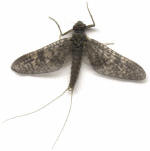 |
|
"Yakima-March Brown Mayfly" |
|
|
|
Wading anglers at times find discouragement because they
don't often encounter this unique spring time emergence.
Being in the right place at the right time can be
crucial. |
|
|
Fishing on foot limits your ability to cover the water and river thoroughly
and effectively
even with the river operating at its current low levels. |
|
|
|
Speaking of river levels,
we have seen a rise in CFS over the past couple of days. This
has not effected the fishing or the clarity of the
Yakima. If you remember, most of our spring
run-off came off the Cascades in January. |
|
|
|
|
|
Even with the
recurring rain and showers we have experienced over the week, its
doubtful we will see the river blow out this year for any extended
period of time. It was good to see the Yakima get a new shot
of water. Its stirred up all kinds of wonderful little
critters! |
|
|
|
Exciting news from the
Washington Fish & Game commission earlier this week. The
Klickitat River season has been extended and will open on
Friday, April 1st, two months before the start of the regular Summer
Steelhead season. Increased runs of Spring Chinooks and Summer
Steelhead are expected. Some limitation are in place for the
month of April, however the entire system will open the first day of
May. Bookings are now being taken for the Klickitat Summer
Steelhead season. |
|
|
|
Fly fishermen enjoying the
still waters of the eastern portion of our state report a
consistency in their fishing. Chironomid's for the most part
have been the best producer.
Blackstone Lake
is no exception. Excellent hatches of
Chironomid's are occurring daily. The leech and bugger fishing
has had proven results as well. Some April dates are still
available for guided fishing tours. 888-950-FISH |
|
|
|
|
|
As the days of March
quickly turn, a convergence of aquatic insects are making a
daily appearance on Central Washington's Yakima River.
Skwala Stoneflies, smaller Winter Stones, Blue Wing Olives and
yes, March Browns are all present throughout the system.
As the first official day of spring arrived, Sunday March 20th,
an ushering of spring mayflies emerged with it. |
|
|
|
Sunday sparked an
emergence of Mayflies unlike we have yet to see this year
and the days proceeding it have produced blankets of these
mayflies equally well. A weekend of snow
and rain showers draped a fair amount of moisture on the
valley and surrounding foothills giving everyone, especially
the farmers in the Kittitas Basin a small hope of
encouragement. More moisture is predicted throughout
the week, which is great to see. Baetis thrive and
emerge in great gatherings during and after a rain shower. |
|
|
|
Dense, dark cloudy
days generally provide us with fantastic dry fly fishing,
especially now with the low, clear water conditions.
Trout feeding freely under the cover of overcast skies. |
|
|
|
The mayfly hatch
begins in the early afternoon as Baetis Duns begin appearing
about noon. The fish commence their feeding, meticulously
slurping them from the surface as the water becomes littered
with Blue Wing Olives. As the late afternoon approaches,
the March Browns begin materializing. The trout quickly
turn their feeding attentions from the blue winged duns to this
brilliantly colored mottled wing mayfly. The March Brown
hatch is short lived lasting anywhere from 15 to 45 minutes.
Each day varies in intensity as well as each section of the
river. |
|
|
|
As the March Brown
slowly diminishes for the day, the trout will once again resume
feeding on the smaller Baetis Duns. This is also a good
time to begin with the larger Skwala patterns. The trout
have now been looking up for several hours and chances they have
filled their belly with a stonefly or two over the past several
days. You find success into the latter portion of the day
casting these likely imitations. |
|
|
|
|
|
March has roared in
like a lion bringing mostly warm seventy degree fly fishing days
on Central Washington's blue ribbon trout stream, the Yakima
River. A succession of consecutive warm, sunny days has
the river's water temperature on the rise and with it a chain
reaction of events has begun to unfold. Bugs, bugs and more
bugs! |
|
|
|
The much
anticipated Skwala Stonefly hatch is underway. Nests
of stonefly nymphs have been massed along the banks for the
past several months eagerly awaiting their time of
emergence. |
|
|
The early morning
sunshine incites a bustling of activity along the shore line
as the smaller males clamor around the females for a
procreation period. |
|
|
By early afternoon
the females are returning to the water either by flight or
by foot to deposit the fruits of conception. An assurance
that the cycle of life continues. |
|
By early afternoon Baetis
Mayflies also begin an emergence and the Yakima's trout
begin to meticulously work the surface, grazing at their
leisure. |
|
|
Feeding can be
sporadic at times depending on the intensity of the aquatic
hatch. |
|
|
Some areas of the
river tend to produce a much broader concentration of these
blue winged mayflies. |
|
|
Click Thumbnail To Enlarge |
|
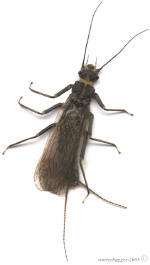 |
|
Skwala
Stonefly-Adult Female |
|
|
The Yakima Canyon
south of Ellensburg for example usually generates a more
pronounced emergence of Baetis. Murky water conditions
in that area of the river provide a safety of cover for
surface feeding fish, unlike sections of the upper river
that are flowing low and clear. |
|
|
Another important
factor to consider when fish over the next several weeks will be
the out migration of salmon smolt.
|
|
|
The last several
years, the Yakima has produced tremendous returns of King
Salmon.
|
|
|
Tiny fry or par are
now beginning to show up in the back waters and slow moving
pools of the river, where last years spawning fish built
their nests. |
|
|
Out ward downstream
movement could come earlier this year with warming water
temperatures. You won't want to be on the river
without some streamer imitations during this time. |
|
|
|
|
|
For those that may prefer
fishing the still waters of the state, we've have great reports at
the shop all
week from fly fishermen returning from the popular central basin lakes such
as Lenice, Nunnally and Lenore. Chironomid fishing has
been the most productive according those reports.
Others are finding success with buggers and leech
patterns.
|
|
|
|
However, if you are in
search of solitude don't expect to find any there. The public
lakes are crowded with anglers fishing the banks as well as from
tubes. If you are in search of peace, solitude and exceptional
fishing you may want to consider
Blackstone Lake
. Worley Bugger is currently taking
reservations for late March and April guided tours. |
|
|
|
March 4th-2005 |
|
|
The first days of
March have begun and with it the start of spring fly fishing on
Central Washington's Yakima River. Warm, sunny, windless
days occupy the blue ribbon river valley as the start of our
aquatic insect season is beginning.
|
|
|
|
The chilly night
time lows of
February are now replaced by warmer, frost free nights.
Early morning lows hover above the freezing level,
which in turn result in the water and air temperatures
rising much sooner in
the morning. Consequently, a variety of aquatic creatures living
in nymphal form below the currents of the Yakima are
stirring. |
|
|
|
The Baetis Mayfly and Skwala
Stonefly are at the beginning of their yearly cycle. With the
prediction of
warming weather over the next several days, we could witness a river
bear its aquatic fruit and hatch the match dry fly fishing
will be underway. The rivers water temperature just
over the past couple of days has risen over ten degrees in
some sections. The warmest I have yet to record it at
is 45°. At 47-48° the Skwala Stoneflies stir from
their nests along the banks and crack loose from
their nymphal skeleton. Here, we find them both male and
female clamoring along the banks in adult
form. |
|
|
|
During the week, we
have experienced some dry fly fishing during the afternoons.
The rivers rainbows are feeding selectively on Midges
and tiny Baetis mayflies. With the Yakima's volume
flowing low and clear
in combination with a cloudless, bright, sunny day, the
majority of surface feeding was generally the smaller class of fish. The bigger,
wary
rainbows hold deeper, feeding safely below the surface under the
cover of darker waters as Beatis, Cased Caddis and Rock-worms float
haplessly through the water column. |
|
|
|
Stonefly nymphs,
preferable the smaller Skwala nymphs this time of year are
always a good choice for searching the deep undercuts, ledges, runs and
pools. Several species of stonefly nymphs are abundant
throughout the year in
the waters of the Yakima and are a consistent dietary fuel for
Yakima trout. |
|
|
|
The eastern basin lakes as well as
many others around the Evergreen State officially opened the first day of March as well
as the private still water fishery,
Blackstone Lake
. For the most part, we have received
good reports thus far from Lake Lenice and Lake Nunnally. This
weekend we are sure will prove to be a busy one at these two public
fisheries. The private still water of Blackstone is also
fairing very well. Chironomid's are hatching in the early afternoon
as fish cruise the deeper depths feeding on emerging larvae. The water temperature now is 44-45
degrees in the afternoon, so the trout's metabolism is on the rise. The lake is in excellent
condition and spring fishing at
Blackstone Lake has now opened. Please call early to
arrange your tour of Blackstone or the Yakima River with our guide
service. The warm,
mild winter we experienced here in the Kittitas Valley was easy on the
rainbows and a fishermen couldn't
ask for better daily weather conditions. |
|
|
|
February
22nd-2005 |
|
|
|
Crisp, clear February mornings
are now a familiarity across the Yakima River Basin.
Frosty night time lows drape the valley in a chilly, wintry
blanket. The fog filled days of January have departed as
the bright Kittitas Valley sunshine beams warm, sunny rays
across the basin. As the month progresses, the hours
in the day grow longer and the temperate rays of the Central
Washington sun glow warmer each day. A benefit for
us a Yakima River fly fishermen. |
|
|
|
With temperature dropping to the low teens each night, the
necessity to rush to the river impulsively in the morning
can prove frivolous.
Allow that morning sun to thaw the valley and bring the air
temperature up to a comfortable level. By mid morning
the temperature has risen and the activity around the Yakima
begins. Small adult Midges bursting from tiny larvae begin
to materialize. These tiny insects vary in emergence and skim
across the water in single form or congregate in clusters. |
|
|
|
Balls of aquatic
food drift slowly with the current creating an attractive,
hearty meal for a Yakima River Rainbow. Some days you
encounter this feeding event, while other days not a
riser ring or proposing dorsal can be seen. Each
fishing day is different as these events provide us with new
and unique fishing challenges. |
|
|
|
With water
temperatures fluctuating between the low to mid thirty degree
range, trout are far less apt to move to feed. The river is low,
clear and in prime condition for February fly fishing. As
a result, aquatic food forms are being funneled into exacting
areas of the river. The trout continue to occupy specific water
types and are readily feeding on a variety of aquatics floating
through the water column. |
|
|
|
Drifting nymphs has
been the most productive method of fishing during the first
portion of this month. With variable water temperatures
each day, other methods have proven far less reliable.
However, as our days progress and the water temperature
increases,
the river will begin to offer a variety of productive techniques.
These methods of Yakima River fly fishing will become an
important and exciting part of your fishing day. Skwala
adults will become visible floating along the shoreline.
Blue Wing Olive duns will also appear in the afternoon and the
first portion of our dry fly season will be underway.
|
|
|
|
Stonefly nymphs
continue to be a main sustenance as the Skwala awaits its
transformation from nymph to adult. Hordes of these early
spring stones have gathered along the banks waiting for the
opportune time and temperature to emerge. Spring Baetis
nymphs are also becoming visible in these croppings. With
water conditions low and a major portion of our winter run-off
already completed, spring fishing on Central Washington's Yakima
River should provide some very memorable days of fly fishing. |
|
|
|
I am happy to report
that
Blackstone Lake
has faired very well
over the mild winter. Spawning activity is already
underway in specific areas of the lake. The majority of
the thin ice that formed in January is no longer present.
A fine layer each morning exists due to the cool night time
lows. However, by mid morning it quickly disappears thanks
to the Kittitas Valley sunshine. We are projecting a March 1st opener for this stillwater
fishery. Please plan and reserve your spring
fishing on Blackstone or the Yakima in advance. Days are
beginning to fill quickly for spring fishing. |
|
|
|
Last week a fellow
Yakima River fly fishermen's pontoon boat was stolen from North
Bend. If you have any information please contact the
Worley Bugger pro shop or call the number listed on the photo.
Click this
link for more information. |
|
|
|
|
|
As the first days of
February get underway, warm rays of sunshine beam across
the Kittitas Valley and the Yakima River Basin. With day time
temperatures soaring into the low 60"s, the remaining days of
winter are creating a pleasant weather illusion much like we see
during the month of May. However, this analogy may be a
bit premature as rain or snow showers are forecasted later in
the week.
|
|
|
|
The dramatic change in weather conditions has brought fly
fishermen out of their January hibernation as many took to
the water this weekend in search of a wildly treasure. The night time lows
continue to drop into the freezing level in the
Kittitas Valley, so frosty, early mornings stubbornly persist.
However, air temperatures warm quickly and by mid morning
you may find yourself shedding a layer or two. |
|
|
|
The Yakima continues to operate at a higher than normal
capacity for this time of year, though river flows are
dropping daily. Main tributaries
like the Teanaway River as well as several other small
feeder streams are the culprits. They continue to spew
in the remaining snow pack from the Kittitas Valley
foothills and lower portions of the Cascades. You will
find sections of the river below this area high, however
wading opportunities for the bank fishermen can easily be
found and the river safely navigated. |
|
|
|
Starting your day to early in the
morning can be futile. Plan your day accordingly
allowing the time needed for the Central Washington sunshine
to warm the water and air temperature.
Being on the river by 9:00 a.m. will insure you plenty of
good fishing time.
With the Yakima operating at a higher volume, several
different species of aquatic creatures are being flushed
into the rivers water column. Here, trout easily feed
at their discretion. Be prepared to encounter a
variety of unique situations like these
throughout the system where river volume is higher. |
|
|
|
The Skwala Stone fly nymphs are amassed in vast gatherings along
the banks of the river as well. Uncovering rocks
along the shore line will reveal hordes of nesting stoneflies,
eagerly anticipating their time of emergence. Over the past
couple of days, we have already started to see adult Skwala
activity in some areas of the lower river. At this time,
the water temperatures is hovering in the low 40's. A few
degrees higher and we could see a an array of adult activity
form. |
|
|
|
With the warming trend
continuing, the thin layer of ice that formed for a short period
during the month of January on Blackstone Lake is quickly
dissipating as well. If the warm weather persists, this pay
to play still water could open this month for early spring
fishing. Ranked as one of the
best of four still water fisheries in the state, the popularity of
Blackstone has quickly earned a solid reputation and strong
yearly following among die hard lake fishermen. Days for spring
tours are booking daily. Please call in advance for
daily availability. |
|
|
|
|
|
It's the final week of
the new year and like most January's its routine, as the usual
daily scenario is played out. The low lying fog extends
along the valley floor, blanketing the surrounding hillsides.
Some days the warm rays of sunshine penetrate the thick cloud
cover, while other days it has little effect. These solid,
dense fog banks shroud the valley with little signs of fading. |
|
|
|
After a week of frigid
cold temperatures and freezing rain showers, warm weather across
the western states arrived, creating an unusual mixture of
temperatures and weather conditions. Road and mountain
pass closures stranded motorist on both sides of the Cascades as
hazardous conditions
triggered life taking accidents, reeking havoc across the state. |
|
|
|
River conditions are now subsiding, decreasing daily after
the Yakima's stream
volumes exceeded the 7000 cfs mark. Large chunks of
ice that formed during the subzero temperatures were torn
free of the banks and easily propelled
downstream by the raging winter river.
The river volume
still remains high and fast in places for this time of year,
however winter fly fishermen have returned to the Yakima and
are finding success. The discharge of sand and silt
has settled and water clarity is no longer an issue. |
|
|
|
The portion of
snow pack that has been slowly building in the Cascade
Mountain Range is quickly dissipating, leaving many
wondering about summer water resources. A slight chance of precipitation
in the form of snow is forecasted over the next several days.
However, with the occurrence of warm temperatures we are
experiencing, the moisture will most likely come
in the form of wet rain showers. |
|
|
|
After a week of
high river volume, the Yakima's resident fish populations are
having little trouble finding ample food sources. The migration of
spring stones (Skwalla) that have been amassing along the banks
for the past several weeks are providing the fuel for the foraging
fish. Sculpins, bait fish and a
variety of other food forms are also easy targets during higher stream flows. These are ideal times to concentrate
your efforts on various streamer techniques. |
|
|
|
Spring fishing is
right around the corner. The guide service of Worley
Bugger Fly Co. is taking reservation for spring fishing for the
Yakima as well as the popular still-water fishery,
Blackstone Lake
. Please call early to reserve your day of spring
fishing with Central Washington's
preferred, professional guide service.
|
|
|
|
|
|
As the tenth day of
our new year begins, a strong, winter weekend storm has
blanketed the Kittitas Valley with snow fall. So
far about 6 to 8 inches of fresh powder has fallen around the valley
as continued snow showers are predicted for the remainder of the
week. This is good news for fish, farmers and the Yakima
River Reservoirs. |
|
|
|
With
the unusual low percentage of snow fall and unseasonable like
weather conditions during the month of December, spring water
reserves were beginning to look rather bleak. Now with
changing weather patterns, a week of scattered snow storms could
begin to build a base for our spring and summer water sheds. |
|
|
|
Despite the colder
conditions, the river has fared well and remains in excellent
shape for some winter time fishing. We did experience a
day or two of heavy slush ice and floating bergs forming in the
river late last week. This was due to single digit
temperatures, however 30 + degree days have warmed things up
around the river and conditions at this time are good.
|
|
|
|
Concentrate your
best efforts during the peak hours
(10:00 a.m.-3:30 p.m.)
of the day.
Indicator fishing in essential trout holding areas has proven
the more efficient form of fly fishing for the first portion of
the new year. You will find some fish responsive to
streamers in area's of the river where Sculpin and other
baitfish activity is prominent. Happy New Year to all! |
|
|
|
|
|
|
|
|
|
|
|
|
|
|
|
 |
|
|
306 South Main #3
Ellensburg, WA 98926
888-950-FISH
www.worleybuggerflyco.com
worleybugger@elltel.net
|
|
|
|
|
|
This fly fishing journal
is constructed and maintained by Worley-Bugger for fly fishers by
fly fishers! © 2005 All Rights Reserved |
|
|
|
|
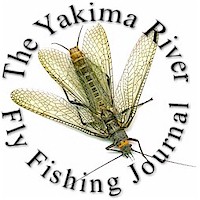

![]()
![]()
![]()
![]()
![]()
![]()
![]()
![]()
![]()
![]()
![]()
![]()
![]()
![]()
![]()
![]()
![]()
![]()
![]()
![]()
![]()
![]()
![]()
![]()
![]()
![]()
![]()
![]()
![]()
![]()
![]()
![]()
![]()
![]()
![]()
![]()
![]()
![]()







